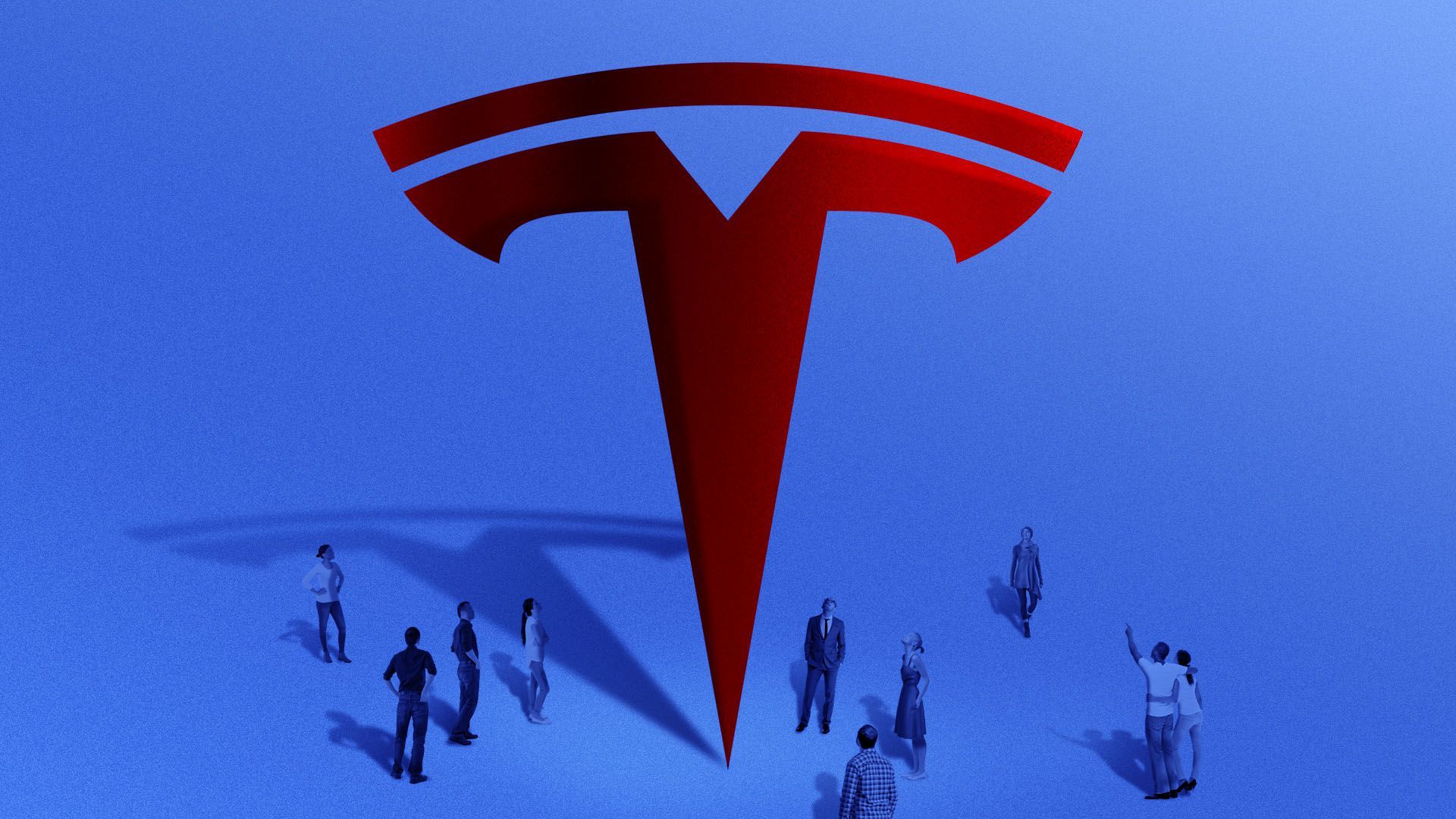| | | | | | | Presented By the National Mining Association | | | | Generate | | By Ben Geman ·Feb 12, 2021 | | Good morning. Today's Smart Brevity count is 1,266 words, 4.8 minutes. 🗓️ We'll be off Presidents Day on Monday, so look for Generate again Tuesday. 🚨 The 51st state? On Sunday's "Axios on HBO," Alexi McCammond talks Puerto Rico statehood with the island's newly elected leader, Governor Pedro Pierluisi. (See clip) - Tune in for this and more can't-miss interviews at 6pm ET/PT on all HBO platforms.
⛵ And happy birthday to yacht rock legend Michael McDonald, who brings us into the weekend... | | | | | | 1 big thing: Biden's innovation push comes into partial focus |  | | | Illustration: Sarah Grillo/Axios | | | | The White House is taking the first steps to creating a new cross-agency federal R&D organization for climate technologies, but there's plenty we still don't know about the effort. Why it matters: Biden's overall climate plan calls for a much more muscular federal role in scaling up research and commercialization of next-wave tech, even as it looks to speed deployment of existing low-carbon sources. Driving the news: Thursday brought the announcement of a "Climate Innovation Working Group." - The working group is co-led by the White House offices of Domestic Climate Policy, Science of Technology and Policy, and Management and Budget.
- Part of its mission is to "advance" plans to stand up Biden's proposed Advanced Research Projects Agency-Climate, or ARPA-C.
The big picture: We'll get back to ARPA-C in a moment, but overall the White House said the innovation group will focus on advancing and lowering costs of a wide set of technologies including... - Carbon-neutral construction materials
- Much cheaper energy storage systems
- Carbon-free hydrogen
- Air conditioning and refrigeration that does not use planet-warming gases
- Zero-carbon heat and industrial processes for heavy industries like cement
- Advanced soil management and other farming practices that remove CO2
- Ways to retrofit existing industrial and power plants with CO2 capture
What we don't know: If the White House will ask Congress to formally create and fund ARPA-C, which would give it more permanence if lawmakers do it. A White House official said, "more specifics are forthcoming." The intrigue: ARPA-C may sound familiar because of the Advanced Research Projects Agency-Energy (ARPA-E) created under 2007 legislation and got its first funding in 2009 (and itself is modeled after the military's DARPA). Similarities between the Energy Department's ARPA-E and the ARPA-C concept extend beyond just the sound. - "The precise boundaries between the two ARPAs aren't entirely clear," MIT Technology Review reports.
- "[S]ome energy observers are confused about why the administration wants to expend political capital trying to set up and fund a new research agency rather than focusing on boosting capital for existing programs," the piece notes.
Speaking of ARPA-E, yesterday the Energy Department announced a $100 million solicitation for proposals, calling it the "first of billions of dollars of DOE R&D opportunities to be announced this year." |     | | | | | | 2. Manchin to Biden: Support natural gas | | The chairman of the Senate's energy committee wants President Biden to consider the "many benefits of responsible domestic natural gas production" as the administration crafts its executive energy policies. Why it matters: West Virginia Democrat Joe Manchin's position, spelled out in a new letter to Biden, comes as Manchin is poised for an influential role in the administration's legislative efforts. Beyond leading the energy panel, Manchin's vote is important because of the Democrats' razor-thin Senate majority. The big picture: The letter from Manchin, whose state has substantial gas output, says the U.S. production boom has bolstered energy security, supports lots of jobs and has given the U.S. geopolitical leverage. The intrigue: Gas is a point of tension within the Democratic coalition. - Lawmakers from gas-producing states don't see eye-to-eye with environmentalists who want much more aggressive steps to transition away from all fossil fuels.
- Natural gas spews far less CO2 than coal when burned for power. But releases of the powerful greenhouse gas methane further up the development chain are a big problem.
- Manchin's letter calls for use of current tech and innovation to curb methane releases, and efforts to advance CO2 capture tech for industrial gas applications.
|     | | | | | | 3. Tesla faces scrutiny over crypto carbon and range |  | | | Illustration: Sarah Grillo/Axios | | | | Tesla is riding high these days, but two developments could create reputational risks for the world's most valuable car company (though admittedly "could" is doing some work there). Driving the news: Tesla is beginning to face criticism over the climate effects of its big new investment in bitcoin and the decision to accept it as payment — even though EVs are lower-CO2 alternatives to gasoline vehicles. Why it matters: Bitcoin "mining" to process transactions is very energy-intensive, so promotion of its use could add to its carbon footprint. Though it's worth noting that some estimates of bitcoin energy use are probably way too high and there are ways to make mining cleaner too. What they're saying: Ben Dear, CEO of the sustainable investment firm Osmosis Investment Management, tells Reuters that "We are of course very concerned about the level of carbon dioxide emissions generated from bitcoin mining." - He said Tesla should disclose energy consumption associated with its bitcoin ventures.
- More broadly, some analysts see Tesla's decision to accept bitcoin as potentially widening its use in transactions more broadly.
- Reuters says Tesla's bitcoin backing could "turbo-charge global use of a currency."
- The Verge is also reporting on the climate angle.
Driving the news, part 2: New research from Edmunds finds that five Tesla models they tested showed less range per charge than the vehicles' EPA estimates. - The analysis, which Edmunds notes is designed as a "real-world complement to the EPA's laboratory-based process," found the vehicles had 2.5%-17.4% less range.
- The one with 17.4% less was a 2018 Model 3 Performance edition, which had 256 miles of range instead of 310 in the EPA estimate.
But, but, but: Tesla still had two of the five longest-range vehicles among the 15 models Edmunds tested. The biggest difference between the EPA and Edmunds findings was with the 2020 Porsche Taycan 4S, which went 59% further in the Edmunds test at 323 miles. Of note: Gasoline-powered vehicles can also underperform their EPA estimates, and in general, mileage and range are influenced by all sorts of conditions and driving styles. The bottom line: Tesla's on a good run, having become consistently profitable. But the EV market is getting more competitive, so these topics are worth keeping an eye on. |     | | | | | | A message from the National Mining Association | | Our economic recovery depends on mining | | |  | | | | This week, we've highlighted the importance of minerals mining for the future of energy, infrastructure and America's post-COVID-19 recovery. Next steps: Policymakers can work to support the U.S. mining sector while maintaining strong environmental protections. Support mining. | | | | | | Bonus: The market harmony of Tesla and Bitcoin |  Data: YCharts; Chart: Axios Visuals Axios' Felix Salmon reports Tesla is closely aligned with Bitcoin in terms of market value, which makes it seem that as far as the markets are concerned, what's good for bitcoin is good for Tesla, and vice versa. Felix has more in his Axios Capital newsletter. |     | | | | | | 4. The future of "smart" cities is in street lights |  | | | Illustration: Annelise Capossela/Axios | | | | Axios' Jennifer A. Kingson reports that cities are rushing to replace legacy street lights with "smart" LED fixtures that could one day monitor air quality, help you find parking and announce an oncoming thunderstorm. Why it matters: Despite a bumpy and controversial start to some smart street light programs, cities are saving money on energy by banishing traditional bulbs — and may soon be able to turn a profit by monetizing data from smart LED sensors or leasing space on light poles. The big picture: There's been lots of hype about "smart cities," where connected technology helps governments serve us better — but also lots of money wasted on projects that fizzled or caused public outcry over police use of camera surveillance. Today, hopes have coalesced around the potential for "smart" street lights, which bear sensors that can do everything from analyzing traffic patterns to assisting 911 operators. - "Streetlights are becoming the backbone of larger smart city initiatives," per a report by the Northeast Group, a smart cities market intelligence firm.
- Cities will invest $8.2 billion in them in the next 10 years, the report said.
- "Overall, over 90% of streetlights will be LED by 2029 and 35% will be connected," Northeast Group said.
Cities large and small have been replacing traditional streetlights with LEDs, which consume less energy and can be programmed to dim or brighten as needed. - "Street lighting can be up to 40% of a city's energy bills, so you see huge cost savings across the board," Benjamin Gardner, president of the Northeast Group, tells Axios.
Go deeper |     | | | | | | 5. On my screen: Market risks all around! | | A new Wall Street Journal piece reports on "early signs of a new wave of investment" in liquefied natural gas projects that could risk creating another glut. Meanwhile, this Bloomberg story looks at the huge valuations of clean energy companies that don't make money yet, including players in the EV and battery space. From the story... - "The Wildherhill Clean Energy Index, which tracks the clean-energy sector, has seen its value surge more than 300% to $1.3 trillion during the past year. Its 56 member companies posted combined net losses of $6.4 million in the 12 months ending in September 2020, according to data compiled by Bloomberg."
|     | | | | | | A message from the National Mining Association | | Our economic recovery depends on mining | | |  | | | | This week, we've highlighted the importance of minerals mining for the future of energy, infrastructure and America's post-COVID-19 recovery. Next steps: Policymakers can work to support the U.S. mining sector while maintaining strong environmental protections. Support mining. | | | | | | Axios thanks our partners for supporting our newsletters.
Sponsorship has no influence on editorial content. Axios, 3100 Clarendon Blvd, Suite 1300, Arlington VA 22201 | | | You received this email because you signed up for newsletters from Axios.
Change your preferences or unsubscribe here. | | | Was this email forwarded to you?
Sign up now to get Axios in your inbox. | | | | Follow Axios on social media:    | | | | | |







No comments:
Post a Comment